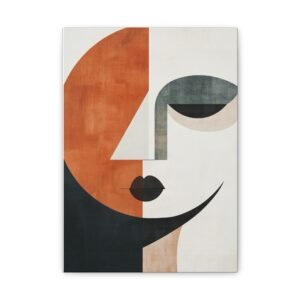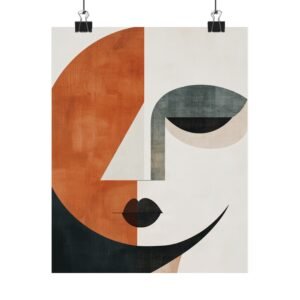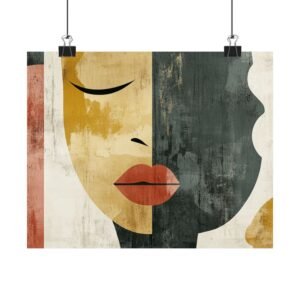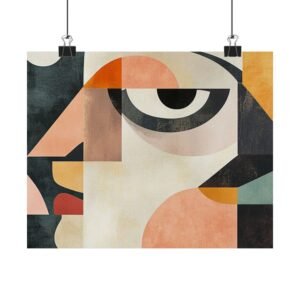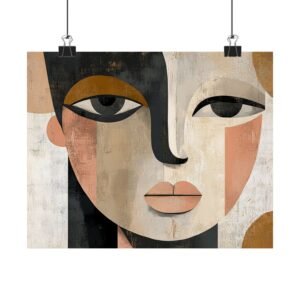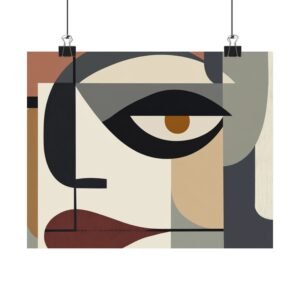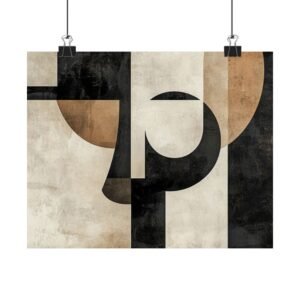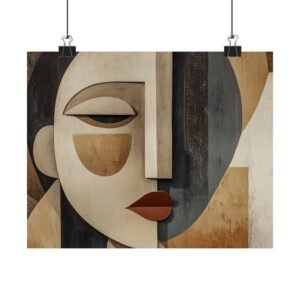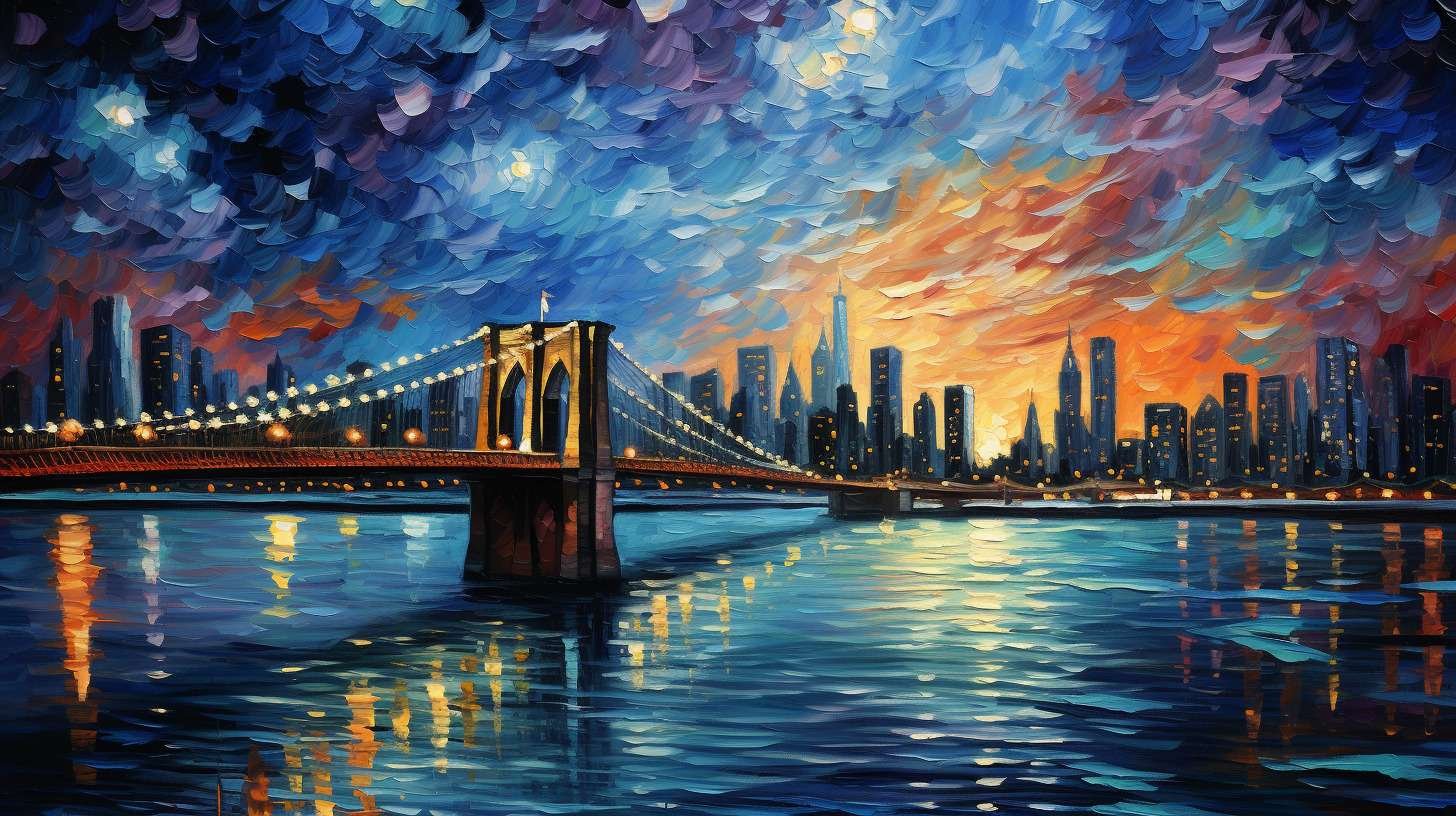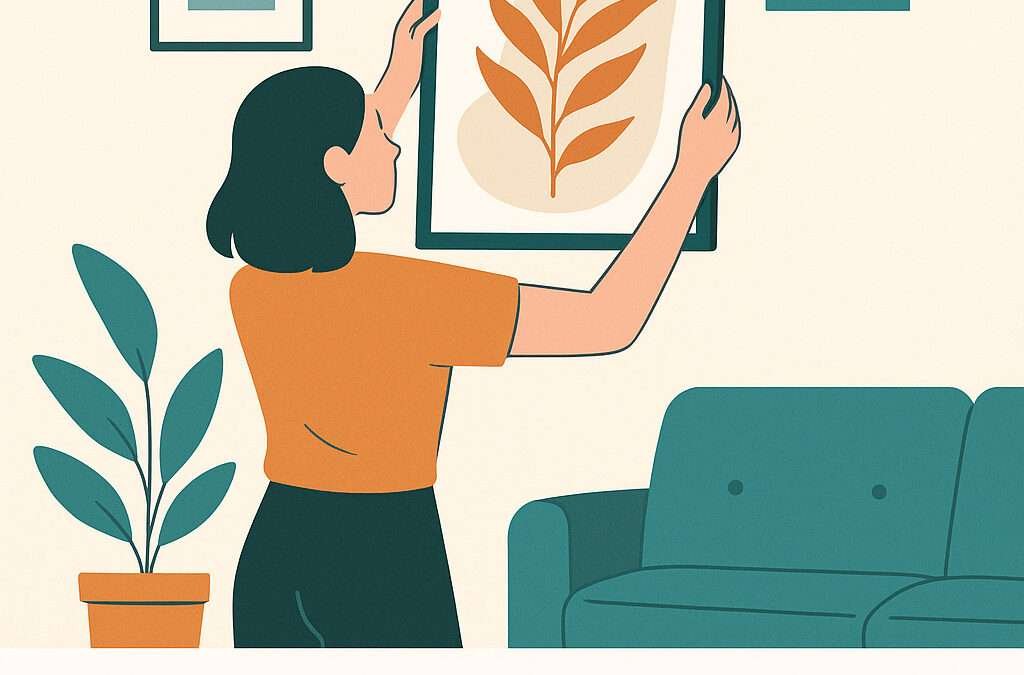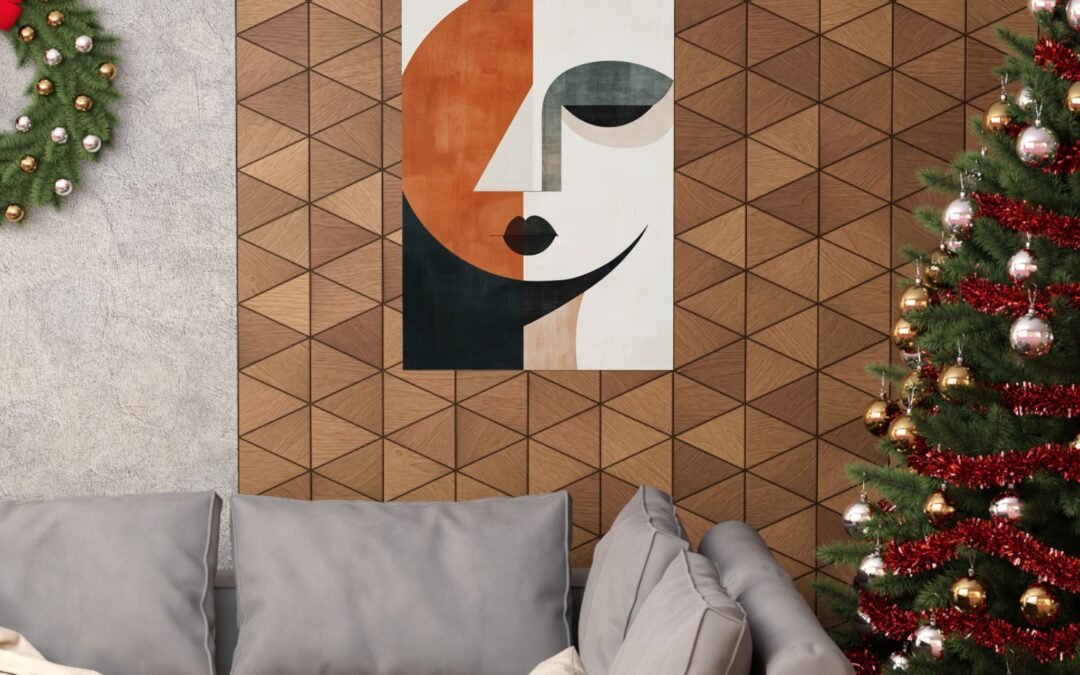
by Richard | Sep 21, 2025 | Art and Decor
The Psychological Impact of Wall Art
Wall art serves not only as aesthetic decor but also plays a significant role in influencing psychological well-being. Numerous studies have highlighted a direct correlation between visual surroundings and mood, suggesting that well-designed spaces can positively affect mental health. For instance, in environments such as schools, the presence of vibrant and engaging wall decorations can enhance students’ learning experiences and foster motivation. These visual elements create a stimulating atmosphere, making it easier for students to focus and engage with their educational material.
In stark contrast, the absence of wall art or the presence of dull, uninspired environments, such as those often found in correctional facilities, can have deleterious effects on inmates’ mental health. Research indicates that inmates in prisons with thoughtful design elements, including murals or colorful wall art, reported lower levels of anxiety and aggression. This suggests that incorporating wall art can alleviate the harshness of such settings, promoting a more rehabilitative atmosphere that encourages personal growth and reflection.
The psychological impact of wall art extends beyond mere aesthetics; it resonates with individuals on an emotional level. Art can evoke memories, stimulate conversation, and inspire creativity. For instance, thoughtfully curated artwork in healthcare facilities can calm patients, thereby aiding their recovery process. Studies have shown that patients exposed to visually appealing art experienced reduced stress levels and faster healing times. This highlights the necessity of integrating wall art into various environments to promote a sense of comfort and well-being.
Overall, whether within educational, rehabilitative, or medical settings, the integration of wall art significantly contributes to an environment’s emotional tone, reinforcing the argument that aesthetic considerations are paramount for fostering positive mental health outcomes. Prioritizing the inclusion of wall art can undoubtedly transform spaces and minds alike.
Wall Art in Educational Settings
In elementary schools, the inclusion of wall art plays an integral role in creating a stimulating and engaging learning environment. Various forms of educational posters, murals, and motivational artwork can significantly enhance the overall atmosphere of a classroom. The visual stimuli provided by wall art address different learning styles and help to accommodate the diverse needs of students.
One of the primary benefits of educational posters is their ability to simplify complex information, aiding comprehension. For example, posters that illustrate language concepts, mathematical formulas, or scientific processes can serve as quick references that reinforce learning. As students interact with these visuals, they are more likely to engage with the subject matter, leading to increased retention of knowledge. Furthermore, colorful and vibrant artwork can capture students’ attention and stimulate curiosity, thereby promoting a more dynamic approach to education.
Additionally, motivational artwork can inspire creativity and cultivate a positive mindset among students. Through the incorporation of encouraging quotes or images that depict growth and achievement, educators can foster a culture of aspiration. These motivational elements remind students of their potential and the importance of perseverance, which can be particularly beneficial in an elementary school setting. It encourages them to approach challenges with enthusiasm rather than fear.
Moreover, wall art can contribute to enhanced classroom management by promoting positive behaviors. When students are exposed to visual reminders that highlight core values such as respect, teamwork, and responsibility, they are more likely to internalize these concepts. As a result, the overall classroom environment becomes more harmonious and conducive to learning.
In conclusion, the strategic use of wall art in educational settings, particularly in elementary schools, serves numerous functions that contribute to a positive and effective learning environment. By enhancing comprehension, inspiring creativity, and encouraging positive behavior, wall art transforms not only the physical space but also the mental landscape of young learners.
Cultural Significance of Art in Public Spaces
The cultural significance of art in public spaces cannot be overstated. These venues serve as vital repositories of collective memory and identity, drawing individuals from various backgrounds to engage with creativity that transcends linguistic barriers. When people travel to museums and art galleries worldwide, they seek not only to appreciate aesthetic beauty but also to experience the emotional resonance that art provides. It acts as a universal language; through color, form, and texture, artists convey profound messages that can inspire a shared understanding among diverse audiences.
Public art plays an essential role in evoking emotions and creating a sense of belonging within communities. The presence of artwork in shared spaces fosters interactions among residents and visitors alike, encouraging dialogue and collaboration. For instance, murals, sculptures, and installations can spur conversations about local history, social justice, or environmental issues, allowing people to connect over common themes and concerns. This interaction nurtures emotional attachment not only to the artworks themselves but also to the places where they reside, encouraging pride in one’s community and identity.
Furthermore, art in public spaces has the power to transform ordinary environments into vibrant ones, making them more inviting and accessible. Visitors are often moved by the narratives and reflections embodied in each piece, facilitating a deeper personal connection to the artwork and the broader social context it emerges from. This transformative experience can inspire creativity and innovation, inviting individuals to express their ideas and stories through the prism of art. Therefore, the cultural significance of art in public venues extends beyond mere decoration; it is fundamental to nurturing community spirit, enriching cultural dialogue, and enhancing the overall experience of public spaces.
Motivational Wall Art in the Workplace
In contemporary work environments, motivational wall art has emerged as a powerful tool for enhancing corporate culture and employee satisfaction. Organizations increasingly recognize the pivotal role that visual elements play in influencing workplace dynamics. By integrating motivational quotes and aesthetically pleasing imagery into their decor, companies foster a positive atmosphere that can inspire employees, boost morale, and encourage productivity.
Motivational wall art serves multiple functions in the workplace, acting as a constant source of inspiration and reflection. For instance, phrases such as “Believe in Yourself” or “Teamwork Makes the Dream Work” prompt employees to cultivate a sense of community and personal accountability. These visual elements act as gentle reminders, reinforcing goals and aligning employee mindset with the organization’s mission. This integration of motivational quotes not only emphasizes core values but also demonstrates a commitment to employee well-being, ultimately contributing to a more harmonious work environment.
Numerous organizations have successfully implemented motivational wall art to enhance their corporate culture. A prominent example is Google, which features vibrant murals and thought-provoking quotes throughout its offices. This initiative is designed not only to engage employees but also to stimulate creativity and innovation. Similarly, companies like Zappos and Airbnb employ motivational imagery to portray their core beliefs graphically, thereby creating spaces where employees feel valued and appreciated. These cases illustrate that investing in wall art can lead to improved employee morale, greater collaboration, and an overall increase in productivity.
Ultimately, the integration of motivational wall art into the workplace is not merely an aesthetic choice; it is a strategic investment in human capital. By cultivating an environment that celebrates creativity and motivation, companies can unlock the potential within their workforce, leading to enhanced performance and a thriving corporate culture.
Family Photos: A Personal Touch to Decor
Family photos serve as a powerful form of wall art that adds a deeply personal touch to home decor. They carry sentimental value that can evoke feelings of love, nostalgia, and warmth, transforming a mundane space into a sanctuary filled with cherished memories. When displayed creatively on walls, these images not only enhance the aesthetic appeal of a room but also provide a unique narrative, reflecting the story of those who inhabit the space.
Incorporating family photographs into home decor allows individuals to create a visual tapestry of their lives. Each picture captures a moment in time, whether it be a joyous family gathering, a milestone celebration, or a candid snapshot during a vacation. This curation of memories fosters a strong emotional connection to the past, providing comfort and reassurance, especially during challenging times. The act of reminiscing over these images can evoke powerful emotions, making the home feel alive and infused with personality.
The placement and arrangement of family photos play an essential role in how they contribute to the ambiance of a living space. A well-organized gallery wall, for example, can serve as a dynamic storytelling medium, guiding visitors through the family’s history and experiences. Alternatively, a single framed photo can serve as a focal point in a room, drawing attention and prompting conversations. As such, these personal artifacts are not merely decorative; they are crucial in crafting a welcoming environment that resonates with warmth and familiarity.
Ultimately, family photos are more than just images adorning the walls. They symbolize love, connection, and history, making any house feel truly like a home. By thoughtfully incorporating these visuals into decorating schemes, individuals can enrich their living spaces with meaningful stories that reflect their unique identities and family values.
The Artistic Value of Motivational Quotes
Integrating motivational quotes into wall decor has emerged as a prevalent trend in interior design, demonstrating both aesthetic and psychological benefits. These carefully selected phrases not only beautify a space but also carry profound implications for personal development and emotional wellness. The juxtaposition of art and inspiration creates a unique atmosphere that resonates with individuals, fostering a sense of positivity and motivation.
One of the primary advantages of displaying motivational quotes is their ability to serve as visual reminders of one’s values and aspirations. Positioned prominently on walls, these quotes can inspire feelings of perseverance and optimism. They encourage individuals to adopt a positive mindset, which can be particularly impactful in environments such as offices, classrooms, or homes. By immersing oneself in these powerful affirmations, individuals often find an uplift in their energy levels, leading to increased productivity and focus throughout the day.
Moreover, motivational quotes enrich the aesthetic appeal of any room, adding depth and character. The artistic representation of words — through typography, colors, and innovative designs — can harmonize with the overall decor, enhancing the visual experience. Whether framed or painted directly onto walls, the integration of such quotes transforms plain spaces into dynamic works of art.
Beyond their visual charm, these affirmations foster a collective identity among groups, be it families, teams, or communities. They become a cornerstone of shared values, enabling individuals to unite under common goals and aspirations. This communal aspect enhances motivation and encourages collaboration.
Thus, the integration of motivational quotes into wall decor is not merely an act of beautifying a space; it is an intentional step towards cultivating a positive environment that influences mindset and behavior. Through this unique blend of artistry and inspiration, individuals can experience profound changes in their daily lives and overall well-being.
Wall Art as an Expression of Identity and Taste
Wall art serves as a significant medium for individuals to express their identity and personal taste. The artwork displayed in a space can reveal a person’s interests, values, and aesthetic preferences, making it an essential aspect of one’s environment. From modern and abstract pieces to classic paintings, the variety of styles available provides endless possibilities for personal expression. Each choice reflects an aspect of the owner’s personality and helps in communicating deeper meanings to those who view it.
Modern art, characterized by its innovative forms and techniques, often attracts those who value contemporary aesthetics. This style can signal a progressive mindset, an appreciation for creativity, and a willingness to embrace change. Conversely, classic art may appeal to individuals who appreciate tradition and history. Such artwork often evokes nostalgia and can ground a space, linking present experiences with cultural heritage. Each medium—be it painting, photography, or sculpture—carries distinct connotations that contribute to how one expresses their identity.
Furthermore, wall art can serve as a conversation starter, providing insight into an individual’s background and passions. For instance, abstract art may appeal to those who value emotional expression and ambiguity, while a collection of travel photography could indicate a love for exploration and adventure. In many cultures, specific artistic styles may resonate more deeply, reflecting societal values and communal narratives. Thus, the artwork chosen not only personalizes a space but also promotes engagement with a broader narrative, bridging gaps between personal experiences and collective cultural identity.
In conclusion, wall art plays a vital role in revealing personal identity and taste, allowing individuals to communicate their values and interests through various artistic styles and mediums. By thoughtfully selecting art for their spaces, individuals can create an environment that is uniquely reflective of who they are, enhancing both their surroundings and their sense of self.
Creating Sacred Spaces with Wall Art
Wall art serves not only as decoration but also as a powerful medium for transforming living spaces into places of significance and spiritual connection. The careful selection of artwork can elicit a profound sense of serenity and belonging, thereby turning ordinary rooms into sacred spaces that reflect individual values and aspirations. This transformation is particularly evident in homes, where art can foster an atmosphere of peace and relaxation.
When chosen thoughtfully, wall art has the potential to evoke deep emotional responses. For instance, nature-inspired pieces may bring the tranquility of the outdoors inside, mimicking the calming effects of a serene landscape. Alternatively, abstract works can invoke feelings of introspection and contemplation, encouraging individuals to pause and reflect. Wall art can thus create a sense of calm, prompting a meditative state that contributes to overall well-being.
Incorporating art that resonates with personal beliefs and experiences further strengthens the connection individuals feel to their spaces. Spiritual art, such as pieces depicting symbols from various cultures or belief systems, can serve as reminders of one’s faith and values, solidifying a sense of place and purpose. The presence of such art can foster an environment conducive to mindfulness and self-care, nurturing both emotional and mental health.
Moreover, wall art in communal areas of the home can act as a catalyst for conversation and connection among family members and guests. Inviting others to share their thoughts about the art fosters an inclusive atmosphere, making such spaces feel warm and inviting. Overall, wall art plays a crucial role in shaping the ambiance of a living space, transforming it into a sanctuary that embodies comfort, relaxation, and a deeper sense of connection to oneself and the world.
Choosing the Right Wall Art for Your Space
Selecting wall art is a significant aspect of home or office decoration, as it can profoundly influence the atmosphere of a space. To begin the process of curating a thoughtful collection, individuals should consider their personal taste as well as the space’s requirements. One of the first considerations should be the color scheme. Choosing artwork that complements or contrasts beautifully with existing colors can create a harmonious look. For example, if a room features neutral tones, a pop of vibrant color through a piece of art can create focus and energy.
Thematic cohesion is also vital when selecting wall art. Individuals should reflect on what themes resonate most with them, whether they prefer abstract designs, landscapes, figurative works, or photography. Well-chosen themes can evoke emotions and create a dialogue within the space. Additionally, when contemplating placement, it is essential to take into account the dimensions of both the wall and the artwork. Larger pieces may work best as focal points over sofas or beds, while smaller artworks can serve as accents in groupings or galleries.
Size plays a crucial role in visual impact; therefore, measuring wall areas prior to purchasing art can help in making informed decisions. It is advisable to envision how the art will look once hung on the walls, ensuring that it maintains visual balance within the environment. Apart from size, considering the nature of the environment — whether it is a lively family room or a serene office space — will also guide the selection process. Ultimately, the right wall art can enhance aesthetic appeal, foster a sense of coherence, and contribute to an inviting ambience that reflects one’s personality.
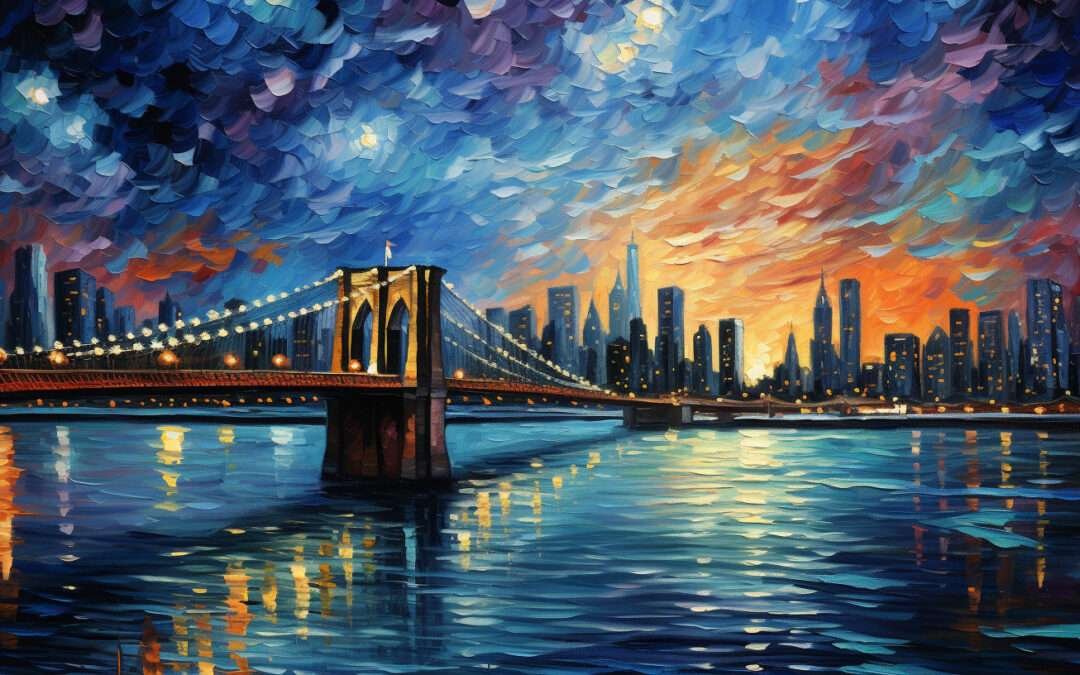
by Richard | Sep 10, 2025 | Interior Design
The Importance of Wall Art
Wall art serves a crucial role in shaping our personal spaces, significantly influencing our emotional state and overall environment. From childhood, many individuals have vivid memories of their surroundings, often characterized by the artwork that adorned the walls of their homes. These formative experiences frequently carry into adulthood, where choices regarding wall art become a reflection of personal identity and aspirations. The types of art selected—be it paintings, photographs, or mixed media—can convey feelings of nostalgia, joy, or even serenity, thereby creating a connection between our past and present.
In adult settings, wall art can transcend mere decoration, transforming a mundane area into a personal sanctuary. It can evoke specific emotions, enhance creativity, and foster relaxation. For instance, vibrant colors might infuse energy into a workspace, while calming tones can establish a soothing atmosphere in a bedroom. By thoughtfully choosing artwork that resonates with individual experiences and preferences, one can curate a space that promotes well-being, comfort, and inspiration. This transformation underscores the importance of wall art not just as decor, but as an essential element in nurturing a positive living environment.
The selection of wall art often stems from utilitarian and aesthetic considerations, yet its importance extends far beyond visible appeal. Artworks can tell stories, capture moments in time, and serve as focal points around which spaces are organized. They provide opportunities for self-expression and create a dialogue between personal taste and broader cultural messages. Therefore, integrating wall art into personal spaces is a powerful way to enhance emotional connections, making living and working environments not just visually appealing, but also emotionally enriching.
Art as a Reflection of Self
The wall art we select for our environments often serves as an intimate reflection of our identity, values, and emotional state. Each piece possesses the unique ability to convey profound messages about who we are, and the artwork we choose to display can significantly affect our self-esteem and overall well-being. For many, wall art acts as a form of personal expression, allowing one to curate a space that resonates with their innermost thoughts and feelings.
The relationship between art and psychology is well established, indicating that our surroundings influence our mood and mindset. Research suggests that engaging with visually stimulating artwork can lead to emotional upliftment, thereby fostering a sense of confidence and positivity. Moreover, the colors, themes, and styles in the art we select contribute to creating an atmosphere that either boosts or hinders our psychological comfort. For instance, vibrant, lively pieces may inject energy into a space, while muted tones may evoke tranquility and calmness.
Additionally, the art we surround ourselves with can reveal nuances of our personalities. Someone who favors abstract art may embody a free-spirited nature, while an affinity for classical pieces may indicate a preference for tradition and stability. This reflection often extends beyond personal preference; it captures stages of life, emotional experiences, and personal transformations. The evolution of one’s taste in art can parallel personal growth, showcasing resilience and adaptability.
Choosing wall art thoughtfully has the potential to enhance our living spaces, enriching our surroundings and, ultimately, our self-perception. The right selection can create a cohesive identity that resonates deeply with our life experiences, effectively transforming not only our homes but also our relationship with ourselves and the world around us.
Psychological Effects of Wall Art
Wall art plays a significant role in shaping our living environments and has profound psychological effects on individuals. Numerous studies have demonstrated that the presence of art in our surroundings can influence our emotions, mental clarity, and overall well-being. Colors and images can evoke specific responses—warm colors, such as red and yellow, often stimulate feelings of warmth and energy, whereas cool colors like blue and green can create a sense of calm and tranquility.
In the context of home decor, the type of imagery displayed can also have a notable impact on mood. For instance, landscape paintings or photographs of nature can instill a sense of peace and connection to the outside world, countering the stresses of daily life. Conversely, abstract art may evoke different feelings based on its complexity and form, prompting introspection and thought. Therefore, it is essential to choose artwork that reflects personal preferences and resonates with the desired atmosphere of a space.
Additionally, research indicates that exposure to art can reduce levels of anxiety and enhance cognitive function. Engaging with wall art can provoke creativity, stimulate conversations, and provide inspiration. When individuals curate their living spaces with selected pieces of art, they create an environment that reflects their identity, fostering a sense of belonging and security. This ability to personalize one’s surroundings contributes to overall life satisfaction, making art not just a visual addition but a catalyst for emotional enrichment.
In summary, the psychological effects of wall art extend beyond mere aesthetics. By thoughtfully integrating pieces that evoke positive emotions, individuals can significantly influence their mental state and enhance their everyday experiences within their homes. The art displayed on walls effectively serves as a reflection of personal values and emotional landscapes, showcasing the profound connection between our environments and our well-being.
Picking the Right Artwork
Choosing the right artwork for your living or working space is a vital aspect of creating an environment that resonates with your personal and aesthetic preferences. To navigate the myriad options available, it is essential to consider several criteria that guide your selection process, including personal resonance, aesthetic fit, and emotional impact.
Firstly, personal resonance plays a critical role in selecting artwork. This means that the pieces you choose should evoke a sense of connection or familiarity. Consider what themes, colors, or styles resonate with you on a personal level. Whether it be landscapes that remind you of a cherished memory or abstract pieces that reflect your inner thoughts, opting for art that holds personal significance can transform a space into a true reflection of your identity.
Aesthetic fit is another crucial element to keep in mind. Assess the overall design and decor of your space to ensure harmony between the artwork and your existing furnishings. Pay attention to the color palette, styles, and sizes of the pieces you are considering. An artwork that complements or enhances the aesthetics of the room will contribute to a cohesive overall look, ultimately leading to an inviting atmosphere.
Finally, evaluate the emotional impact of the artwork. Art possesses the power to inspire, provoke thought, or evoke feelings of calm and serenity. Selecting pieces that resonate with your emotions can significantly influence the mood of your environment. Curating a collection that aligns with your values and preferences—whether through socially conscious art or pieces that celebrate your heritage—can create a profound connection within your space.
In conclusion, selecting the right artwork involves personal resonance, aesthetic fit, and emotional impact to curate a collection that truly reflects who you are while enhancing the environment around you.
Creating a Mood Board
Creating a mood board is an essential step in the interior design process, particularly when one aims to enhance their surroundings with powerful wall art. A mood board serves as a visual representation of ideas and inspirations, allowing individuals to curate a collection of images, textures, and colors that reflect the desired atmosphere of a space. To begin this creative endeavor, one should gather a variety of calming images and art pieces that resonate with their vision. Sources for these visuals can include magazines, online platforms, and personal photographs.
Visual coherence is paramount when selecting elements for a mood board. The careful choice of colors and styles helps to establish harmony within a room, making it more inviting and aesthetically pleasing. By incorporating soothing hues, such as soft blues, gentle greens, and warm neutrals, one can foster a serene environment. Additionally, the inclusion of wall art that features organic shapes or abstract designs can further convey tranquility. This combination not only enhances the overall color scheme but also allows for seamless integration of wall art into the chosen space.
A mood board also serves as a valuable creative planning tool, aiding in the refinement of one’s artistic vision. It provides an opportunity to experiment with different combinations of art pieces and colors, enabling the identification of what works best together before committing to any specific design choices. This iterative process can be particularly helpful when assessing how various elements interact in the context of the space. Ultimately, this exercise in creativity encourages individuals to embrace their unique style while promoting an environment that reflects their ethos. Through thoughtful curation of a mood board, one can lay the groundwork for a beautifully designed room filled with impactful wall art.
Bringing Joy and Beauty
Wall art is a transformative element within the confines of our homes, serving not only to enhance aesthetics but also to evoke emotions and forge connections. For many individuals, the experience of selecting and displaying a piece of art is deeply personal, often reflecting their journey and aspirations. For instance, Sarah, a graphic designer from Portland, found herself inspired by a vibrant painting of a sunflower field that now adorns her living room wall. This piece, with its bright yellows and greens, not only enhances the natural light during the day but also instills a sense of calm and happiness that permeates her space. She describes it as a ‘daily reminder of positivity and growth’.
The power of artwork to bring joy can also be witnessed in shared spaces. A recent survey revealed that 78% of respondents felt more connected to their home when it was adorned with personally meaningful art. Consider a family that collects travel-inspired pieces from their adventures; every artwork not only beautifies their space but also serves as a conversation starter and sparks cherished memories. For them, their collection mirrors their collective experiences and values, fueling nostalgia and warmth that elevates the environment.
Moreover, art can be a source of inspiration even in the most mundane routines. Many individuals have reported how a carefully chosen piece positioned near their workspace fosters creativity and motivation. In a corporate setting, an abstract mural can invigorate a sterile office, inspiring employees to think outside the box. This correlation between well-curated wall art and enhanced productivity illustrates how art breathes life into spaces, converting them into havens of joy and creativity.
Connecting with Guests Through Art
Artwork plays a significant role in transforming a space into a reflection of personal identity and taste, thereby fostering connection among guests. When individuals enter a room adorned with thoughtfully chosen art pieces, they are not merely witnessing decorations but are engaging with stories, emotions, and perspectives that resonate with the host’s personality. This deliberate curation of wall art invites guests to share their thoughts, experiences, and interpretations, initiating dialogues that may otherwise remain unaddressed.
Art has a unique ability to break the ice, serving as a focal point in any gathering. As guests admire the artwork, it becomes a prompt for conversation, encouraging individuals to discuss not only the pieces on display but also the underlying principles that reflect the host’s values and beliefs. This exchange can lead to deeper connections as people find common ground or share differing viewpoints, enriching the social experience. Moreover, selecting art that represents various cultures or perspectives can stimulate discussions about diversity and inclusion, making guests feel more welcome and engaged.
Furthermore, the emotional response elicited by art can create an inviting atmosphere. A vibrant painting may evoke joy and excitement, while a serene landscape can instill calmness and relaxation. By selecting wall art that captures the intended mood of the space, hosts can subtly influence the guests’ experiences, making them feel at ease and open to connection. Thus, integrating powerful wall art into one’s surroundings is more than just an aesthetic choice; it is a strategic decision that promotes friendly interactions and meaningful dialogues. Art becomes a bridge, linking diverse individuals through shared experiences and understanding.
The Power of Color and Elegance
The significance of color in wall art extends beyond mere aesthetics; it plays an integral role in shaping the mood and ambiance of a space. Color theory, a framework that explores the relationship between colors and the emotions they evoke, serves as a valuable guide for selecting artwork that enhances elegance and tranquility in various environments. Understanding how specific colors function within this context can lead to dramatic transformations in the atmosphere of your home or office.
For instance, warm tones such as reds, oranges, and yellows are often associated with energy, passion, and warmth. Utilizing these colors in wall art can invigorate a room, promoting lively interactions and stimulating conversations. Conversely, cooler colors like blues, greens, and purples are linked to calmness, serenity, and introspection. Artwork featuring these hues can create a soothing sanctuary, ideal for spaces designated for relaxation and mindfulness.
Moreover, neutral tones, such as beige and gray, can serve a dual purpose. While they provide a subtle backdrop, allowing other elements of the decor to shine, they also contribute to a sense of sophistication and elegance. Selecting artwork that incorporates these colors can evoke a minimalist yet inviting atmosphere, encouraging balance and harmony within the space.
The transformative power of thoughtful art selection lies not only in the visual appeal but also in the psychological impact of color. Art serves as a vital tool for self-expression, allowing individuals to curate their surroundings in a manner that reflects their personal style and emotional landscape. By understanding the emotions associated with various colors, one can thoughtfully choose wall art that enhances both elegance and ambiance, creating spaces that foster desired feelings and interactions.
Conclusion: Your Home as a Canvas
In today’s world, our living spaces serve as a reflection of our identities, personalities, and individual stories. The selection of wall art plays a pivotal role in shaping these environments, acting as a powerful medium through which we communicate our feelings and experiences. By strategically choosing art pieces that resonate with us, we transform our homes into personal sanctuaries that evoke comfort, inspire creativity, and radiate warmth.
Throughout this discussion, we have explored the multifaceted impacts of wall art on our surroundings. From creating focal points to setting the mood of a room, wall art has the potential to elevate interior design beyond mere aesthetics. It engages our emotions and allows us to express our uniqueness. Whether it is through vibrant paintings, subdued prints, or interactive installations, each piece contributes to creating a cohesive narrative that captures our essence.
Moreover, wall art enables us to curate spaces where we can feel at ease and inspired. By being mindful in our selections—considering colors, themes, and styles—we can foster an environment that enhances our well-being. Taking the time to understand what truly resonates with us and our experiences will lead us to make informed choices. This thoughtfulness ultimately reflects our aesthetic preferences and serves as a celebration of who we are.
As we conclude, it is essential to recognize the significance of our choices in wall art, as they shape the backdrop of our daily lives. Embracing our homes as canvases awaiting our artistic imprint invites us to take charge of our environments, making them not only comfortable but distinctly ‘us.’ Therefore, it’s imperative to explore diverse options available and invest in art that speaks to our spirit, turning our spaces into genuine reflections of our journey.

